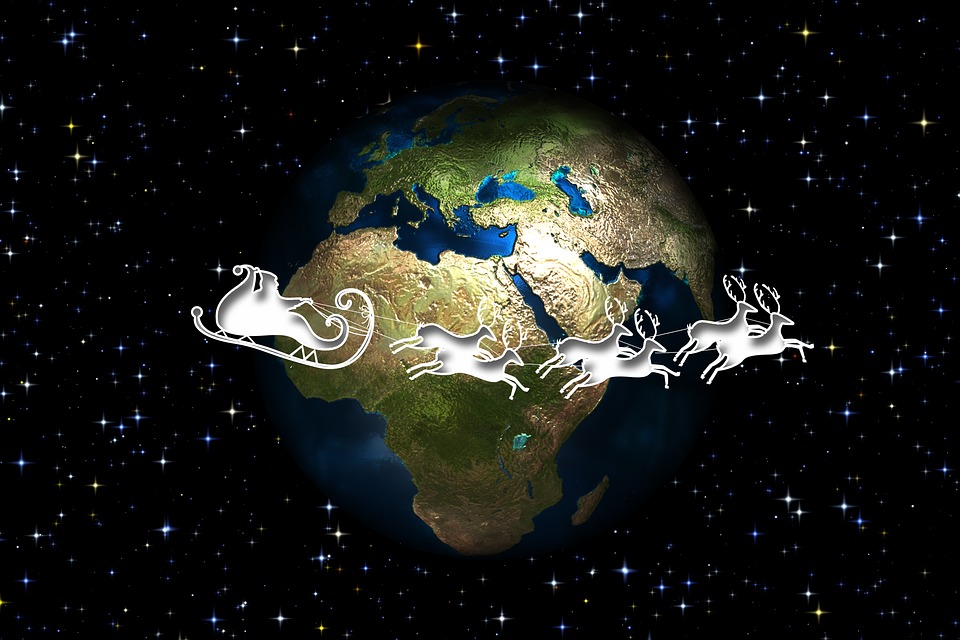Santa’s challenge
Lets establish the problem we are going to analyse in the article. Santa Claus is an elderly, rather large man who spends one night in the year to deliver presents to children all around the world. He travels in a flying sleigh pulled by nine flying reindeers. Once he gets to a house, he parks it on the roof, jumps into the chimney with the right presents, leaves the presents under the Christmas tree, eats his cookies, drinks his milk, climbs back up to the roof through the chimney and is ready to go to the next house. If there is no chimney, Santa has a master key to all doors, so he enters the house through the front door. He does all of this completely unnoticed and without making a mess.
Daddy’s silly triangle
We can assume that every nice child waiting for Santa in the world will go to bed on Christmas Eve at 9pm and wakes up at 7am. We also must take the world’s rotation around its axis which gives rise to time zones which mean there is a 24 hour difference between the east and west. Summing this together implies Santa has 34 hours or 122,400 seconds to deliver all presents. There are about 2 billion children in the world, but only 15% of those children are from Christian families which expect him to come, which reduces the number of children to 300 million. On average each household has 2.5 children and, if we assume that at in each household at least one child is nice, this means Santa has 120 million households to visit in 34 hours which is about 980 households per second. To make our problem simpler, let’s assume that the world has one habitable continent which has a surface area of 220 million square kilometres and the houses are equally distributed over this continent. The distance between houses works out to be about 2 km. If we assume that Santa spends half of the total time he has on travel, then to make it on time he must travel at a speed of nearly 2000 kilometres per second. The fastest manmade object was the NASA’s Juno Mission spacecraft which reached 40 kilometres per second. The top speed of a reindeer is about 0.02 kilometres per second, which is 100,000 times too slow.
Warning – don’t feed the Santa
In each of the households there will be about 3 cookies, 30 grams each, and a 220ml glass of milk left for Santa to eat. This means that in the 34 hours Santa will consume 10.8 million kilograms of cookies and 26.4 million litres of milk. The average American will eat 35,000 cookies in their lifetime and Santa will be having over 10,000 times more in only 34 hours! Unfortunately he will not, because his stomach can hold up to 4L of food and after he eats about 133 cookies his stomach will rupture.
All I want for Christmas is… LEGO
Let’s assume that 75% of the 300 million children are nice and each of them will get one present. One of the most popular presents is a LEGO set, which weighs about 600 grams. To simplify our problem, lets assume each nice child will get such LEGO set. Then 225 million LEGO sets in Santa’s sleigh will weigh 135 million kilograms. This is a tremendous load of presents is nearly equivalent to the weight of 10 blue whales, which are the heaviest animals in the world.
Reindeer on fire
If we ignore the weight of the sleigh, the Santa and the jingling bells, then how many reindeers are needed to pull this load? A reindeer can pull up to about 135 kilograms of load on the ground, so to pull the sleigh in air we can assume that a reindeer can pull 10 times as much. This means Santa would need to recruit about 100,000 reindeers for the job. Also, flying reindeers is some mysterious species of reindeer that has yet to be observed in nature. Now, it was already mentioned that even if the reindeers ran at top speed they would be 100,000 times too slow. However let’s imagine that the nine reindeers can pull the whole load of the sleigh and travel at the necessary speed. As they would fly across the sky, the friction with their body and the atmosphere would produce an immense amount of heat. The poor reindeers would burst into flames and crash.
From a scientific point of view, attempting the Santa’s challenge is not recommended. However, with the help of new technologies of the future, it may not be completely impossible.







